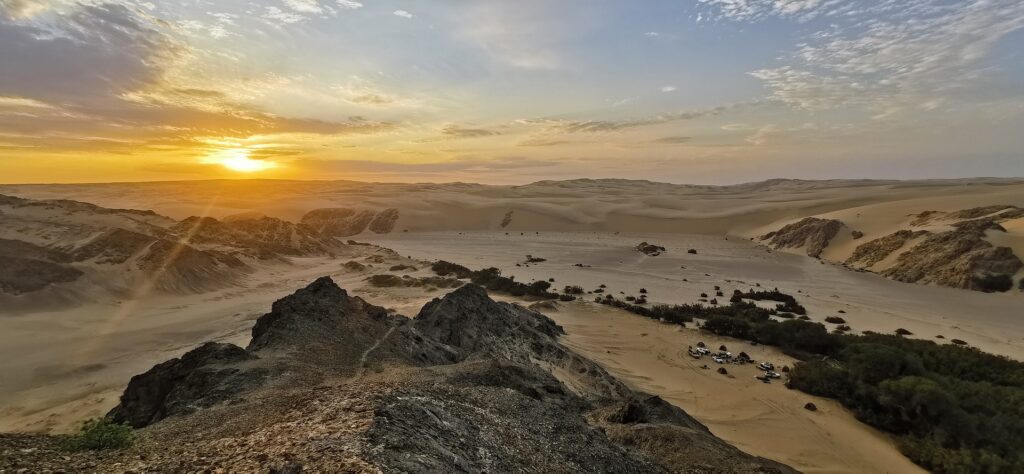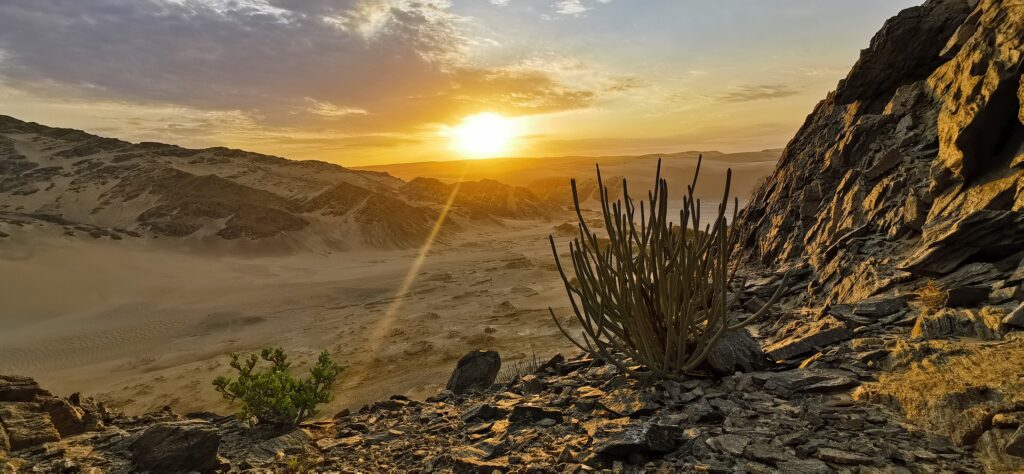The Skeleton Coast – a name that conjures up images of desolation and mystery. Located along the northwestern coast of Namibia in southwestern Africa, this stretch of shoreline has long fascinated adventurers, scientists, and photographers with its hauntingly beautiful landscapes and the remnants of nature it holds. Aptly named, the Skeleton Coast is a place where the remains of both nature and human civilization come together to create a truly enigmatic and unforgettable experience.

Stretching over 500 kilometers between the Kunene River, which marks the border between Angola and Namibia, and the Ugab River, the Skeleton Coast is part of the Namib Desert, one of the oldest deserts in the world. The area is characterized by its harsh environment, with its haunting fog banks, strong ocean currents, and towering sand dunes. These natural elements, along with the icy waters of the Atlantic Ocean crashing against the dunes, have claimed many ships and lives over the centuries, giving the coast its notorious reputation.
More:Read about on Gazing into The Depths of Fish River Canyon
But what truly sets the Coast apart is the contrast between the unforgiving environment and the remnants of life that can be found scattered along its shores. The coast owes its name to the countless shipwrecks that have met their fate in these treacherous waters. It is estimated that over a thousand ships have perished here, succumbing to the rough seas, hidden sandbanks, and thick fog that shrouds the coast.

As you traverse the beach, you can stumble upon the skeletal remains of these ghostly vessels, their rusted metal frames and weathered wooden planks a haunting testament to the destructive power of the sea. It is an eerie sight, as if the ships were frozen in time, forever trapped in their final resting place. Each wreck tells its own story, evoking a sense of wonder and reflection on the lives and journeys cut short by the unforgiving force of nature.
Yet, it’s not just shipwrecks that lie along the Skeleton Coast. This desolate landscape is also the final resting place for countless marine mammals. The Benguela Current, rich in nutrients, supports an abundance of marine life, attracting seals, sea lions, and dolphins to the coast. Sadly, the powerful ocean currents and overwhelming fog have claimed their fair share of casualties, with the skeletal remains of these majestic creatures scattered across the sand. It is a reminder of the cycles of life, and how even the most powerful and resilient species are no match for the raw power of the natural world.
But it is not all doom and gloom along the Coast. This harsh environment also boasts a surprising array of flora and fauna that have managed to thrive amidst the unforgiving conditions. The Namib Desert, where the coast is located, is home to a variety of desert-adapted wildlife, including desert-adapted elephants, zebras, ostriches, and antelopes. These creatures have evolved to survive in one of the harshest environments on Earth, where water is scarce, and food is scarce.

Exploring the Skeleton Coast is not for the faint-hearted or ill-prepared. The harsh climate, vast emptiness, and lack of infrastructure make it a true wilderness area. However, for those seeking adventure and a connection with nature’s raw beauty, it is an experience like no other.
Visitors to the Coast have the opportunity to witness untouched wilderness, devoid of human intervention. The silence and sheer vastness of the landscape are awe-inspiring, giving one a sense of humility and insignificance in the face of such natural grandeur.

In recent years, efforts have been made to protect this delicate ecosystem. The Skeleton Coast National Park was established in 1971, ensuring the preservation of its pristine landscapes and unique wildlife. Its protected status allows visitors to experience the wonder of the Skeleton Coast while ensuring the long-term sustainability of the fragile ecosystems that exist here.
visit here:Odishalifestyle
In conclusion, the Coast is a place of contradictions. It is a hauntingly beautiful landscape, where the remains of nature’s power and human endeavor come together to create an enigmatic and unforgettable experience. It is a place where shipwrecks become part of the landscape, and the skeletons of once mighty creatures still grace the sand. It is a testament to the resilience of life in the face of adversity and a reminder of the delicate balance between humans and the natural world. So, venture forth and uncover the secrets of the Skeleton Coast, for it is a place that will stay with you long after you have left its desolate shores.
What is the Skeleton Coast?
The Skeleton Coast is a remote and mysterious stretch of coastline located in Namibia, Africa. It earned its name due to the numerous shipwrecks and whale bones scattered along its shores.
Why is the Skeleton Coast considered enigmatic?
The Skeleton Coast is shrouded in both natural beauty and haunting stories. Its desolate landscapes, shifting sand dunes, and eerie shipwrecks create an enigmatic atmosphere that captivates adventurers.
What can I expect to see on a tour of the Skeleton Coast?
During a tour of the Skeleton Coast, you can expect to witness stunning landscapes, encounter unique wildlife such as seals and desert-adapted elephants, explore shipwrecks, visit ancient rusting cannons, and experience the raw beauty of an untouched wilderness.
Is it safe to visit the Skeleton Coast?
While the Skeleton Coast is known for its harsh and unforgiving environment, it can be safely explored with the assistance of experienced guides. It’s important to follow their instructions and respect the fragile ecosystem.
What should I pack for a trip to the Skeleton Coast?
It is recommended to pack lightweight and breathable clothing, sunblock, a hat, comfortable shoes, a camera, binoculars, and sufficient water. Depending on your chosen activities, additional gear like camping equipment may be required.
Are there accommodations available near the Skeleton Coast?
Yes, there are accommodations available in nearby towns and within national parks such as Skeleton Coast Park. Options range from luxury lodges to camping facilities, catering to different preferences and budgets.
How can I reach the Skeleton Coast?
The Skeleton Coast can be accessed by both air and road. There are airports in nearby towns, such as Windhoek and Walvis Bay, with connecting flights to various destinations. Alternatively, you can embark on a scenic road trip from Namibia’s capital or other major cities.
Is photography allowed on the Skeleton Coast?
Yes, photography is allowed and encouraged on the Skeleton Coast. The incredible landscapes, wildlife, and shipwrecks serve as fantastic subjects. Just make sure to respect any guidelines or restrictions set by your tour guide or the protected areas.

